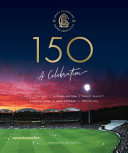150: A Celebration
Martin Chandler |Published: 2021
Pages: 417
Author: Various
Publisher: South Australia Cricket Association
Rating: 4 stars

Here we have a tough book to categorise. In many ways 150: A Celebration is the archetypal coffee table book. To begin with it has an eye-catching design, which will break the ice before it is even opened. More than that it is a large format, splendidly illustrated tome that requires any reader to be seated before reading, and it is of such weight that both hands are needed by anyone seeking to look at it.
The quality of the paper on which 150: A Celebration is printed cannot be faulted either, nor can those hundreds of illustrations. Some were new to me and, a sure sign of the coffee table style, those that are familiar are generally sharper and better defined than I have seen them before. But at the end of the day the quality of the narrative that holds 150: A Celebration together is far too good for it to be the genuine article where coffee table books are concerned. If a guest with the slightest interest in cricket starts looking at this one when he or she visits then you are not going to get much sense out of them for the rest of the evening.
The book’s title makes its purpose clear, and in less imaginative hands it might have amounted to little more than a new and up to date history of the SACA to supplement that written by Chris Harte in 1990. As it is there is a historical layout in the sense that the various essays have an essentially chronological order, but all are separate pieces of writing. The hard yards are put in by Peter Cornwall, Michael Sexton and Ashley Mallett, but there are contributions from eight others, South Australians all.
As any book of this type should 150: A Celebration begins with short introductions from the SACA President and CEO before a foreword from the man who is undoubtedly one of South Australia’s favourite sons, Ian Chappell. Despite being English I have liked Chappelli enormously ever since a brief conversation with him when I found myself stood next to him at a urinal in a pub in Lancashire back in the 1970s. Anybody who doubts his love of, commitment to and knowledge of the game should read the foreword, and then listen to him talking to Graham Barrett on the Ian Chappell Special of the splendid Once Upon A Time In The Ashes podcast.
Many of the essays, spread across 35 chapters, are pen portraits of the great and the good of South Australian cricket, the first being of George Giffen, and the last of Darcie Williams. The name of The Don, for part of his career a South Australian, looms large and although a New South Welshman through and through the legendary Trumper puts in a cameo appearance as well as the story of the Adelaide Test against South Africa in 1911 is told, in which Trumper recorded his Test best 214*. The tragic figure of Archie Jackson gets in on a similar basis, his century on Test debut coming in the Adelaide Test in 1928/29. There is also room for looks at the lives of an Englishman (Jack Crawford) and a New Zealander (Clarrie Grimmett) to be told, both of whom represented South Australia.
The controversy and ill-feeling generated by the ‘Bodyline’ series of 1932/33 reached its zenith in the Adelaide Test, so it is understandable that one of the longer essays, by Cornwall, concentrates on the events of that third Test. In terms of the illustrations this chapter illustrates my earlier point very well. The famous images we have all seen time and again of Bert Oldfield and Bill Woodfull being hit are reproduced once more, but with a clarity and quality I have not seen before.
The bulk of the book looks to the First Class game and in particular Test cricket for its subject matter. That said Grade cricket is not ignored and, from way back in 1874, Mallett reprises the story of Alexander Crooks, a man who caught WG Grace in a match between Grace’s XI and 22 of South Australia and who, subsequently, was sentenced to serve eight years in prison for all but bringing down his employer, The Commercial Bank of South Australia.
At the other end of cricket history is the twenty first century and the coming into greater prominence of the women’s game and the the T20 format. Neither are ignored and, naturally, the rear of the book comprises a detailed statistical appendix put together by Lawrie Colliver. The book can be purchased directly from SACA, or alternatively through the good offices of Roger Page.







Leave a comment